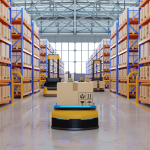A wide gap is emerging in how supply chain organizations are adopting generative AI. While 83% of global supply chain leaders are using traditional AI for automation and forecasting, only 36% have begun implementing generative AI, according to Blue Yonder’s new Supply Chain Compass report.
The disparity highlights how companies are prioritizing investment across functions. Businesses focused on transportation, fulfillment, and order management are leading adoption, while logistics firms and others with lower technology budgets are slower to act.
Fulfillment Moves First, Logistics Lags Behind
Generative AI is gaining ground where operational speed is critical. Among companies managing fulfillment, transportation, and order execution, 46% report using or exploring generative AI tools. In contrast, just 16% of logistics-focused organizations say the same.
These differences reflect function-specific needs. Fulfillment operations benefit from generative AI’s ability to create adaptive plans and simulate responses to disruption. Logistics providers, often constrained by fixed assets and thinner margins, have been slower to justify the cost.
Meanwhile, predictive AI and machine learning are broadly embedded across industries, used for inventory planning, demand forecasting, and routing. Generative AI represents the next layer, one that’s still optional for some but already necessary for others.
Competing Priorities Slow Rollout
Cost remains a key barrier. Firms with supply chain tech budgets under $500,000 are far less likely to explore generative AI. But resistance also comes from leadership culture. Among those not pursuing the technology, 51% cited a preference for people-led decision-making over algorithmic support.
Other companies are prioritizing traditional automation projects, particularly in inventory and procurement. For these firms, generative AI may be a second-phase initiative, following foundational upgrades.
However, delaying adoption comes with risk. As major vendors integrate generative capabilities into core platforms, early adopters may benefit from faster interoperability and supplier coordination, while late adopters face steeper transitions.
Adoption Signals Broader Strategic Alignment
Firms adopting generative AI are also more likely to pursue broader goals, such as sustainability, agility, and real-time data integration. Among these companies, 61% are already investigating generative tools, compared to 36% overall.
That correlation suggests generative AI is becoming a proxy for digital maturity. Adoption is not just about operational gains, but about positioning for longer-term flexibility and control.
The Real Barrier: Decision Rights
The slower pace of generative AI adoption in some sectors isn’t merely about budget constraints or skepticism, it reflects a deeper uncertainty about how supply chains should be governed. When algorithms start shaping execution decisions, trade-offs shift from technical to ethical, operational, and even reputational.
This is why some firms are pressing pause, not out of disinterest, but because the questions they must answer now extend well beyond performance. For those already deploying generative AI, this governance frontier is no less urgent, it just arrives faster.







